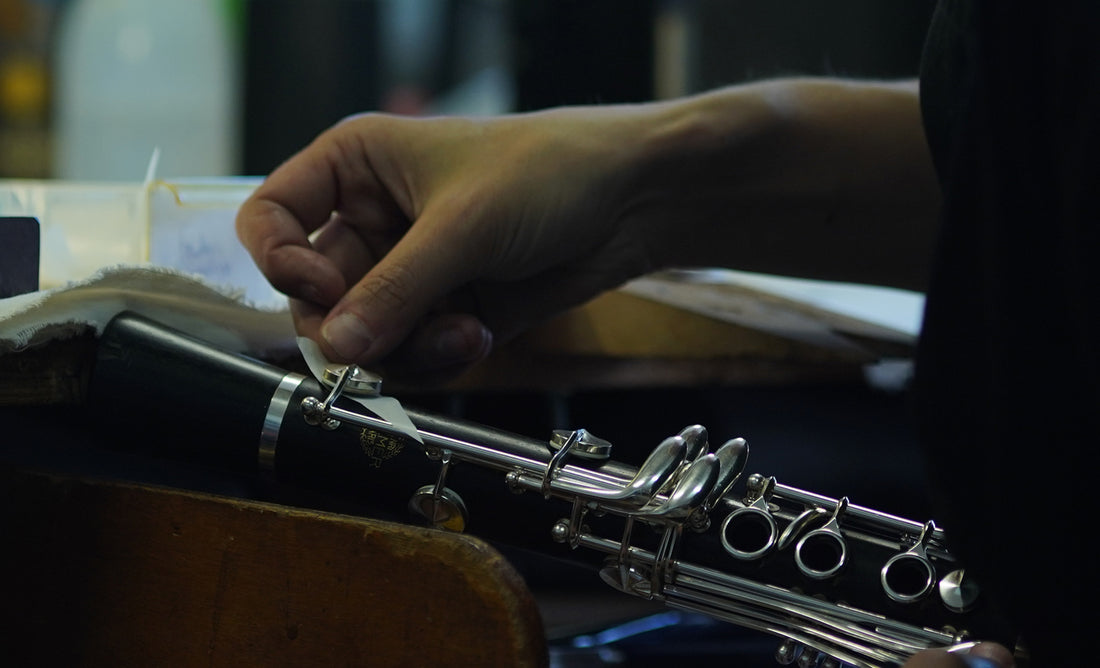Birth of a clarinet in the Henri SELMER Paris workshops

Rough turning and wood drying

Ebony arrives in the workshops in the form of narrow rectangular woodblocks for the bodies or pyramidal shape for the bells: the logs. Work is begun on the outline of the exterior shape immediately. The interior is roughly drilled at the same time. In order to stabilize the wood enough so that it can be properly worked, the barrel, upper joint, lower joint and bell are stored for 3 years in a room with controlled temperature and hygrometry. The clarinet's roughed body undergoes further processing to prevent possible splits in the ebony. The bodies undergo a pressurised linseed oil treatment for 12 hours in an autoclave. The various parts of the instrument are then dried out in a drying oven for several days. Finally, after all these years of treatments and drying, the crafting of the wood can begin.
|
Two precious woods are used in the manufacture of clarinets, ebony (Dalbergia melanoxylon) and rosewood (Dalbergia Stevensonii). They are particularly appreciated for their machining qualities (hardness, tight fibres, dimensional stability) and for their acoustic rendition. The ebony is from Mozambique, while the rosewood comes from South America. Their use, regulated by the Conference on Precious Woods, is regularly called into question. It takes an average of 70 years for these two species to become mature enough for proper use. Before even arriving at the factory, the raw wood is dried by the forest operator over a 5-year cycle. Other species are also used in stringed and wind instrument making: grenadilla wood from Madagascar (Diospyrus Perrieri), from Gabon (Diospyrus Crassiflora) or from Macassar (Diospyrus Celebica). |
Wood turning and drilling

After seasoning the wood is turned again to give it its final dimensions. The dents constituting the sites of the tone holes are marked. The wood pores are stoppered and the body undergoes a careful manual scouring with a fine abrasive. The marking of the dents is finished by hand. Metal linings can be assembled on the tenons, depending on the model.
Next, the sites for the keys and tone holes are bored. Those are conically milled, at their base by the interior of the borer. This is a critical operation in the acoustic definition of the clarinet. These operations are all carried out on digitally controlled machines, equipped with tools formed from carbide ensuring precision and stability in creating the dimensions.

Wood joint finishing

Once the final calibration of the bore has been carried out, the tenon corks are fixed and ground.
The logo is then engraved in the wood using a digital machine. The engraved logo is then hand-gilded.
The body is now ready to receive the keywork.
Assembly

The posts - on which the keywork of the instrument will be mounted - are manually screwed into the bodies. They are milled, drilled and threaded.
The various rods and hinges (axis of rotation for keys) are cut to length and individually checked on standard assemblies.
Mechanical operations

At the same time, the various elements of the keywork are made : the primary parts (keys, posts, mechanics) are machined in nickel silver and less frequently in brass. These, in turn, are variously cut, drilled, bevelled, stamped and milled. They are then inspected and stocked in a specialized store.
The primary parts are assembled by silver soldering on positioning mounts. These sub-assemblies are then inspected and put into storage. They make up the entire keywork of the instrument.

Polishing and silver plating

After having been prepolished in a revolving drum of abrasive pellets, the keys are hand-polished on a lathe.
After dry cleaning and shining, they are checked for uniformity of aspect.
The keys are then silver plated by electrolysis.
Finishing

During the finishing phase, the needle springs are attached to the posts and the keywork assembled along the instrument.
After final boring of the rods and hinges the pads are attached in the caps. Corks and felts are sized and attached on the heels of the keys. The completed keys are set to their final position on the instrument.
This phase of manufacture requires expertise and meticulousness.
Quality check

At the end of the production cycle the instrument undergoes inspection of its form and function.
Since 1998, the approach to quality has been strengthened and a number of actions taken to sensitize the personnel to the exacting requirements mandated by the world class position occupied by Henri SELMER Paris.
Many quality controls are carried out throughout the production cycle, according to very precise criteria. A specific SQA (Selmer Quality Action) corresponds to each phase of manufacture. If the SQA is not good, the instrument is not allowed to continue in the production line. This allows any deviation in manufacture to be avoided, even from very early on in the process.
Each instrument is then blown by play testers who check the acoustics in soundproof cabins.